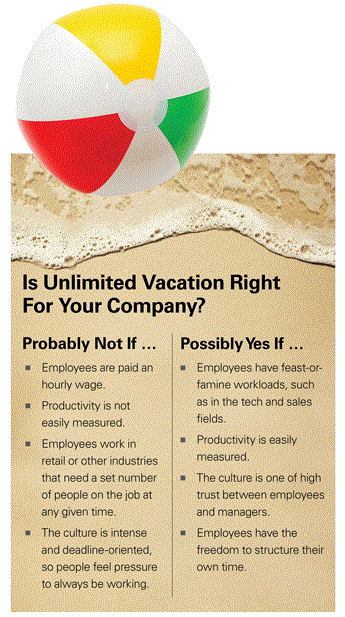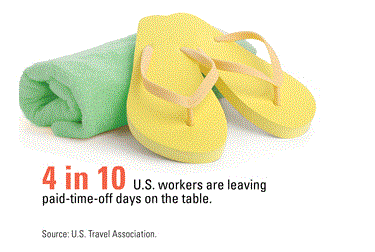The Limits of Unlimited Vacation
Vol. 60 No.2
Unlimited time off can benefit both employees and the bottom line. But before anyone books a trip to Bali, make sure the policy is a good cultural fit for your company.
By Susan Milligan
3/1/2015 - SHRM
Is there any workplace issue as vexing as vacation? Whether it is organized as a single block of days that includes sick time or as its own separate category, the benefit brings about all kinds of contradictions, resentments and perverse incentives among employees.
There are people who complain of stress and overwork yet refuse to take time off. Then there are those who come to work sick, fearful of giving up a day they might want to use months down the road. And what about employees who routinely take sick days when theyfre not sick or who have an extremely liberal interpretation of the term gmental health dayh?
Recently, leaders at many companies have begun to wonder what would happen if they did away with limited time off altogether. What if managers told employees to take all the time they need, as long as their work gets done?
The answer to that question is unfolding as more employers experiment with so-called unlimited vacation time. While relatively few companies offer it—experts estimate about 1 in 100—leaders at those that do say it works swimmingly. The pressure to plan and save days is eliminated for workers, while employers are freed from the administrative hassle of tracking time off and the financial burden of paying out unused vacation time. Itfs a win-win, right?
In some circumstances, perhaps. But itfs not right for every company, a lesson that Tribune Publishing, which owns the Los Angeles Times, recently learned the hard way. When the companyfs CEO announced in November 2014 plans to roll out a gdiscretionary time offh policy—in which employees would have no more set vacation, holiday or sick days and instead would work with their managers to determine their time off—the staff of the Times and other Tribune papers rebelled, with some threatening to sue. The policy was rescinded less than a week later.
Meanwhile, at Netflix, Virgin America and other companies, similar policies have been lauded as the next great workplace perk. Semantics may explain part of the differing reactions: gDiscretionary time offh certainly doesnft sound as appealing as gunlimited vacation.h But the real key, experts say, lies in knowing your culture.
For example, gIf employees donft trust the management, thatfs a reason to look at this skeptically,h says Fred Shilmover, CEO of InsightSquared, a Cambridge, Mass., business analytics firm that has an unlimited vacation policy for its 100 workers.
The Motley Fool, an Alexandria, Va.-based financial services firm with more than 300 employees, holds itself up as a success story. gFor us, the policy is the same for both sick time and vacation: Take what you want, take what you need,h says Samantha Cicotello, senior vice president of customer delight. The company claims to have been the first in the United States to adopt an unlimited vacation policy. gWe donft even track it,h she adds, though she estimates that workers typically take about three to four weeks.
Sometimes employees will take a couple of weeks off to travel overseas, while other times they just want to spend an afternoon taking their kids ice skating. gWhat we want to do is make sure that theyfre refreshed and have time to reflect and disconnect,h Cicotello says.
No-Vacation Nation
Workers and senior managers claim to understand the
importance of paid time off, but when it comes to actually taking the time, both
are reluctant. The typical U.S. employee with paid vacation time took just a
little more than half of his or her allowed time off in the previous 12 months,
according to an April 2014 Harris survey conducted for Glassdoor. Just a
quarter reported taking all the time off given to them, while 2 in 5 said they
had taken 25 percent or less of their available time off.
A full 15 percent had not taken any paid time off at all. gPeople were already not taking vacation time when they had it on a platter,h says Anita Beshirs, chief culture officer, U.S., at the San Francisco-based global communications firm Grayling, which has a no-limits vacation policy for its U.S. workers.
That doesnft serve the company any more than it serves the worker, since exhausted employees are less likely to be productive and committed to their work, and burnout has been shown to be a key factor in employee disengagement. A Gallup study of workers monitored in 2011-12 showed that just 13 percent worldwide were gengagedh at work. In North America, 52 percent were gnot engaged,h meaning they lacked motivation and were less likely to invest discretionary effort in organizational goals or outcomes. Another 18 percent were gactively disengagedh—unhappy, unproductive and liable to spread negativity to co-workers. Gallup estimates that the annual cost of disengaged employees in lost productivity is between $450 billion and $550 billion.
Studies have shown that people have limited attention and that job performance is improved by both short and long breaks. Indeed, more than 90 percent of HR professionals believe that vacation improves wellness, morale, performance and productivity, according to the Society for Human Resource Managementfs (SHRMfs) 2013 Vacationfs Impact on the Workplace survey report.
Some companies are finally getting the message. The digital-sharing company Evernote, for example, withholds a $1,000 bonus from workers who donft take off an entire week at a time during the year. Cicotello at The Motley Fool is also a strong time-off advocate: g[Workers] are going to get burned out pretty quickly if they donft take that time to renew and refresh.h
Would They Use It?
So would employees take more re-energizing time off if there were no limits? Many managers say yes, but others believe workers might feel pressured to stay on the job to impress the higher-ups. And, with no one wagging a finger at them to take time off or lose it, employees might be inclined to just let the time slide.
gItfs like going to the gym,h says Steven Parker, SPHR, head of business transformation at Achievers, an online rewards program for company employees. The intent is there in theory, but gthe next thing you know, youfve only worked out five days in the year. And you donft get those days back.h
Unlike other nations, the U.S. has no laws guaranteeing paid vacation time for anyone. The Family and Medical Leave Act provides for up to 12 weeks of unpaid time off for births, adoptions and health problems, but it applies only to companies with 50 or more workers.
For those who have become accustomed to getting a set number of vacation and sick days, unlimited vacation policies require a fundamental change in the way they view paid time off. Instead of looking at it as part of the compensation package—a perk that grows with time invested at the company—taking vacation becomes less of a gbenefith than a necessity for remaining energized and productive.
The shift in mindset may be a harder adjustment for more-experienced workers who believe they should be rewarded for their tenure with more paid time off. Millennial employees, on the other hand, donft see their career paths going that way; they expect to work at many companies over their lifetimes.
gA generation ago, you might have spent an entire lifetime at one company. That very rarely happens now,h says Shilmover. gThe reality of employment today is that people do change jobs rapidly.h So rewarding tenure with more vacation is not a great strategy, he adds.
It Comes Down to Culture
The key to getting an unlimited vacation policy to work is to create the right culture. That means setting a standard of mutual trust, where both worker and employer trust each other not to abuse the system.
gYou need to be respectful of your co-workers and your clients and get them what they need,h says Mary Beth Wynn, vice president of people at Jellyvision, a Chicago-based multimedia production company with 180 employees that offers unlimited vacation. gBeyond that, we leave it up to you to let us know what you need to be healthy and happy. And we leave it to the manager to address the reasonableness. Itfs a system that requires trust on both sides. We trust our employees not to abuse it, and employees have to trust us that the flexibility is really going to be there.h
Flexibility, however, doesnft mean there are no rules at all. HR should issue a companywide memo explaining what is expected of workers before they take time off, the amount of notice required and the process for getting approval, says Matt Mickiewicz, CEO of Hired.com.
Not only does this give workers a sense of security, but git also creates a forcing mechanism, in that companies are required to articulate goals and hold quarterly performance reviews to hold people accountable based on results, rather than days in the office,h he says.
And Daniel Jacobson, Netflixfs vice president for edge engineering, noted on his blog in 2013 that the companyfs unlimited vacation policy doesnft actually mean workers can take all the time off they want. gIt is a simple mantra that basically states that we are all adults, so letfs all behave and treat each other like adults. And if a person is not consistently behaving like an adult, they should not work at Netflix,h he wrote.
Wynn and others acknowledge that it is hard for workers to come to a company with an unlimited vacation policy after having set time off; younger workers, especially those in firms that have feast-or-famine workloads, such as tech and sales fields, tend to be more adaptable. gIn general, these types of policies work the best when the productivity of the employee is easily measured,h says Kim Cassady, senior director of talent at Cornerstone OnDemand, a Santa Monica, Calif.-based HR services firm.
So, for example, if a salesperson meets her target early in the year, it may be entirely reasonable for her to take a break, even an extended one. But for other jobs—those paid by the hour, for example, or positions where itfs not as easy to determine if the employee is achieving joint goals—unlimited vacation may not be a useful policy for either the company or the employee.
The Benefits of Going Unlimited
An unlimited vacation policy can eliminate the paperwork and scheduling that goes into managing vacation time. gIt makes it so much easier to administer. People are either getting their work done or theyfre not,h and time off should stem from that, says Paul Millard, managing partner of the IT/tech recruiter The Millard Group, based in Middletown, Conn. He says the policy works well in his 20-person office with simple conversations between managers and workers. Millard compares managing a staff to raising kids: gThey need structure, but they also need freedom.h
Financially, companies are in a position to save from adopting unlimited vacation. Itfs not because theyfre counting on employees not to take much vacation; itfs because workers canft stockpile their days for a big payout when employment ends, creating an unofficial severance package. Some companies keep this in check by allowing employees to carry over a maximum number of days into the next calendar year. In California, however, state law bans use-it-or-lose-it vacation policies, requiring companies to pay out all accrued, unused vacation time upon a workerfs departure, explains labor lawyer Chris Boman, a partner with Fisher & Phillips in Irvine, Calif.
gA lot of companies believe their employees are abusing the vacation system,h Boman says. While employees may not be taking formal time off, he continues, they may not be fully functioning at work, either, whether because they are slacking off or taking pockets of unrecorded time. gI think the knee-jerk reaction for employees may be, eIfm losing a benefit,f h Boman says, gwhen really [employers are giving] a compliment to the workforce, saying, eWe trust you to be accountable professionals.f h
Parker, however, sees a colder calculation. gThe real reason [for a change to an unlimited vacation policy] is that therefs a significant impact from a financial perspective.h Legally, he says, HR and the chief financial officer have to account for all unused and accrued vacation as a liability on the balance sheet—an amount that he says could run into the millions for some companies when each worker is carrying an average of $2,000 to $4,000 in vacation-in-waiting.
A Paradigm Shift
In the unlimited vacation paradigm, workers need to take responsibility for their own schedules and make sure theyfre getting what they need out of the bargain. gIt sounds like a cool idea: You can really take as much time as you need, and you donft worry about taking time off to care for a loved one, or to go see a yoga instructor in Bali,h Parker says. But in reality, workers might end up losing, letting time fritter away and then having nothing to show for it on the day they leave the company.
Part of the process may be overcoming our cultural reluctance to vacation, which was aggravated by the recession, says Bruce Elliott, manager of compensation and benefits at SHRM. Even with the economy improving, many workers are wary. gEmployees for the most part are really afraid. Wefre uncertain about our jobs, and thatfs one of the reasons we donft take time off,h Elliott notes.
The solution, Wynn says, is for leaders to set an example by taking vacation and personal days with no apology. At Jellyvision, for instance, gthere is public communication of, eIfm not available because Ifm doing things that are important to me.f That comes down from the top,h she adds.
In the end, people who shy away from using vacation time will likely do so whether or not itfs a guaranteed benefit. So it may take a larger national culture shake-up to convince Americans they deserve a break.
Susan Milligan is a freelance writer based in Washington, D.C.


